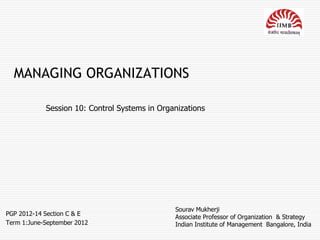More Related Content Similar to Man org session 10_org control_27th july 2012 Similar to Man org session 10_org control_27th july 2012 (20) More from vivek_shaw (20) 1. MANAGING ORGANIZATIONS
Session 10: Control Systems in Organizations
Sourav Mukherji
PGP 2012-14 Section C & E
Associate Professor of Organization & Strategy
Term 1:June-September 2012 Indian Institute of Management Bangalore, India
2. RECAPITULATING WHAT WE SET OUT TO DO 2
STRATEGY
DEPENDENCY IMPACT OF
ON TECHNOLOGY
ENVIRONMENT STRUCTURE &
PROCESSES
1. Centralization
2. Formalization
3. Specialization
CULTURE 4. Coordination SIZE
POWER 5. Control systems AND
POLITICS 6. Learning GROWTH
7. Decision Making
8. Change management
Remaining sessions will be focused
on some critical organizational
processes and their relationships
with structure
© S Mukherji
3. 3
CONTROLS ARE FUNDAMENTAL TO ORGANIZATION DESIGN
Organizations are means to achieve “principal’s” (one or a few individuals) goal through
the efforts of many “agents” . For agents, the organizational objective might be means
to other objectives, not all of which would be aligned to the organizational objective.
PRINCIPAL
AGENT
Organizational control systems try to achieve organizational objectives despite
partial convergence between the goals of the principal and the agents
© S Mukherji
4. 4
CONTROL SYSTEMS OPERATE AT ALL LEVELS IN THE SOCIETY
What are the control systems deployed within the class at IIM
Bangalore ? What are the control systems deployed at the
hostel? How are they different ? Why ?
What are the control systems that are deployed over faculty
members at IIMB?
What are the control systems a mother would deploy if she
employs a driver to take her young children to school everyday?
Will the systems change over a period of time ? Why?
What are the control systems that society imposes on
individuals? Why are they necessary?
© S Mukherji
5. 5
THERE ARE TWO WAYS TO DEAL WITH THE P-A PROBLEM
1. Live with the goal divergence and 2. Increase goal-congruence
try to achieve objectives despite
goal-incongruence
PRINCIPAL AGENT PRINCIPAL AGENT
• Direct supervision • Recruitment, socialization
• Rules and regulations • Inspiration, motivation
• Financial incentives and penalties • Peer pressure, mentoring
related to rule adherence or
performance targets
© S Mukherji
6. 6
DEVISING CONTROL SYSTEMS FOR A GROWING ORGANIZATION
VFM pharmaceuticals is an entrepreneurial organization that has
seen high growth in the first two years since inception. It has now
decided to get more process oriented and abandon its earlier
generalist structure. The senior management has divided the
organization into three divisions – sales, product development and
support services (comprising finance and accounting, human
resource management and administration).
What are the control systems that they should deploy for the three
different divisions?
Should these systems be uniform or should they be different?
What are the characteristics on which these would depend?
© S Mukherji
7. TASK CHARACTERISTICS DETERMINE 7
APPROPRIATENESS OF CONTROL SYSTEMS
Output control is close
High to market based control
Behaviour Behaviour /
• Process Output Needs little or no
• Hierarchy goal congruence
TASK
Risky for agents under
PROGRAMMABILITY
conditions of uncertainty
or absence of information
Output Clan or cultural control is
Clan most difficult to
implement but can be
• Recruitment
Low • Socialization
the most effective
Low High
OUTPUT MEASURABILITY
© S Mukherji
8. ORGANIZATIONS SEEK BALANCE BETWEEN 8
EMPOWERMENT AND CONTROL
Belief Boundary
System Systems
Core values Risks to be
Culture avoided What NOT to do
control
Organizational
objective
Critical
Strategic performance
uncertainties variable
Diagnostic
Interactive Output & Process control Control
Control Direct supervision Systems
Systems Increasing uncertainty
Source: Control in an Age of Empowerment, © S Mukherji
R Simons, Harvard Business Review, 1995
9. 9
EVALUATING ORGANIZATIONS: THE BALANCED SCORECARD
No single measure can provide a clear performance target
How do we look
to shareholders ?
Financial Perspective
• Cash flow
What must we excel at ? • Sales growth
• Market share
• ROE / ROCE
Internal Business Innovation & Learning
• Efficiency • Patents / copyrights
• Target vs. actual • Improvement on
• New product launch existing products
• Exploiting opportunity • New product sales
Customer Perspective
• Service levels Can we continue to
• Customer satisfaction improve & create value?
• Repeat customers
• Reference customers
How do customers see us ?
Source: The Balanced Scorecard: Measures that Drive Performance, © S Mukherji
R S Kaplan & D P Norton Harvard Business Review, 1992
